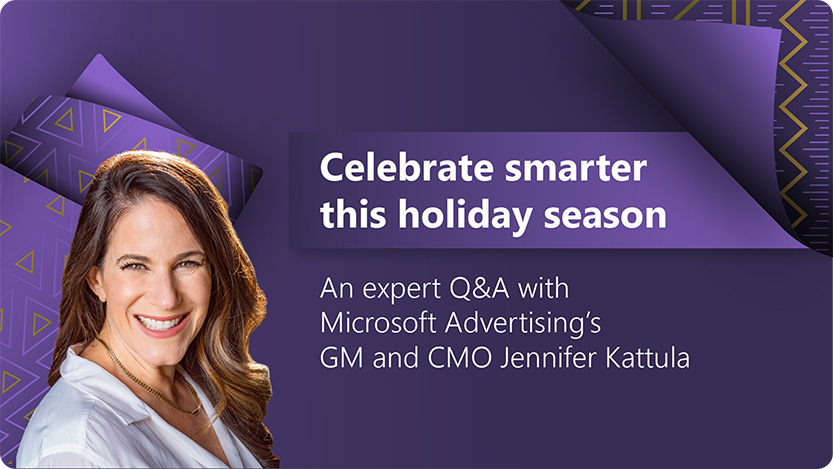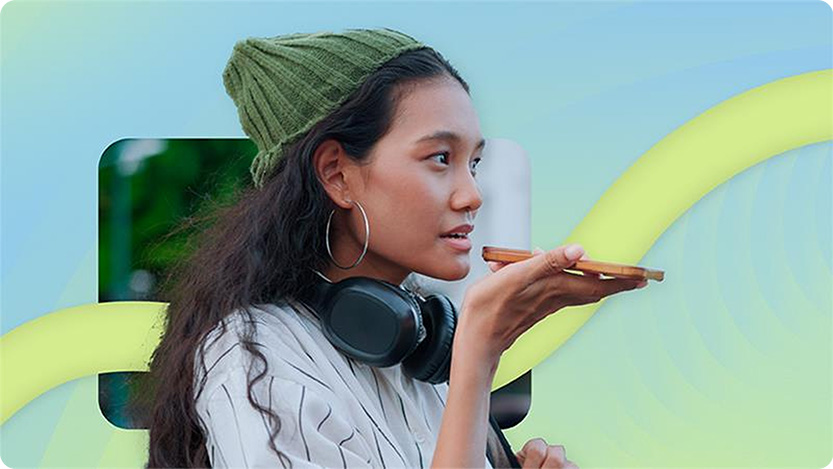Blog post
Holiday 2024 wrapped: Advertising trends that defined the season

Ready to unwrap the possibilities of 2025? Let’s start by looking back at the 2024 holiday season—and what advertisers and retailers did to stand out.
In 2024, digital commerce surged...
- Global advertising revenue was projected to increase 7.8% to $989.8 billion. (GroupM)
- Online holiday sales in the U.S. grew 8.7% year-over-year, totaling $241.4 billion. (Adobe Analytics)
- Global online holiday sales reached $1.2 trillion. (Salesforce)
Brands seeking ways to navigate the 2025 holiday landscape—which will also be influenced by shifting global economic headwinds and possible market volatility—need to make every marketing dollar count.
Here are the most important lessons from 2024 that can help shape your advertising strategy and reach buyers during the holiday season ahead.
The expanding holiday season: Beyond the Cyber 5
Holiday shopping historically peaked around the "Cyber 5,” also known as the five-day period including Thanksgiving, Black Friday, the following weekend, and Cyber Monday for those digital-only deals. However, in 2024, we saw a significant shift in how and when people shopped.
Buying started earlier and continued later. In Europe, for example, the Cyber 5 garnered just 7% of impressions, 9% of clicks, and 12% of conversions throughout the mid-September through mid-December period.1 In the U.S., impressions and click seasonality shifted toward November, but conversions happened earlier.2
January has become the secret MVP of the holiday season. Interestingly, the U.S. noted 25% more conversions after Christmas, which offers ongoing opportunities for advertisers to carry campaigns and revenue into the new year.2
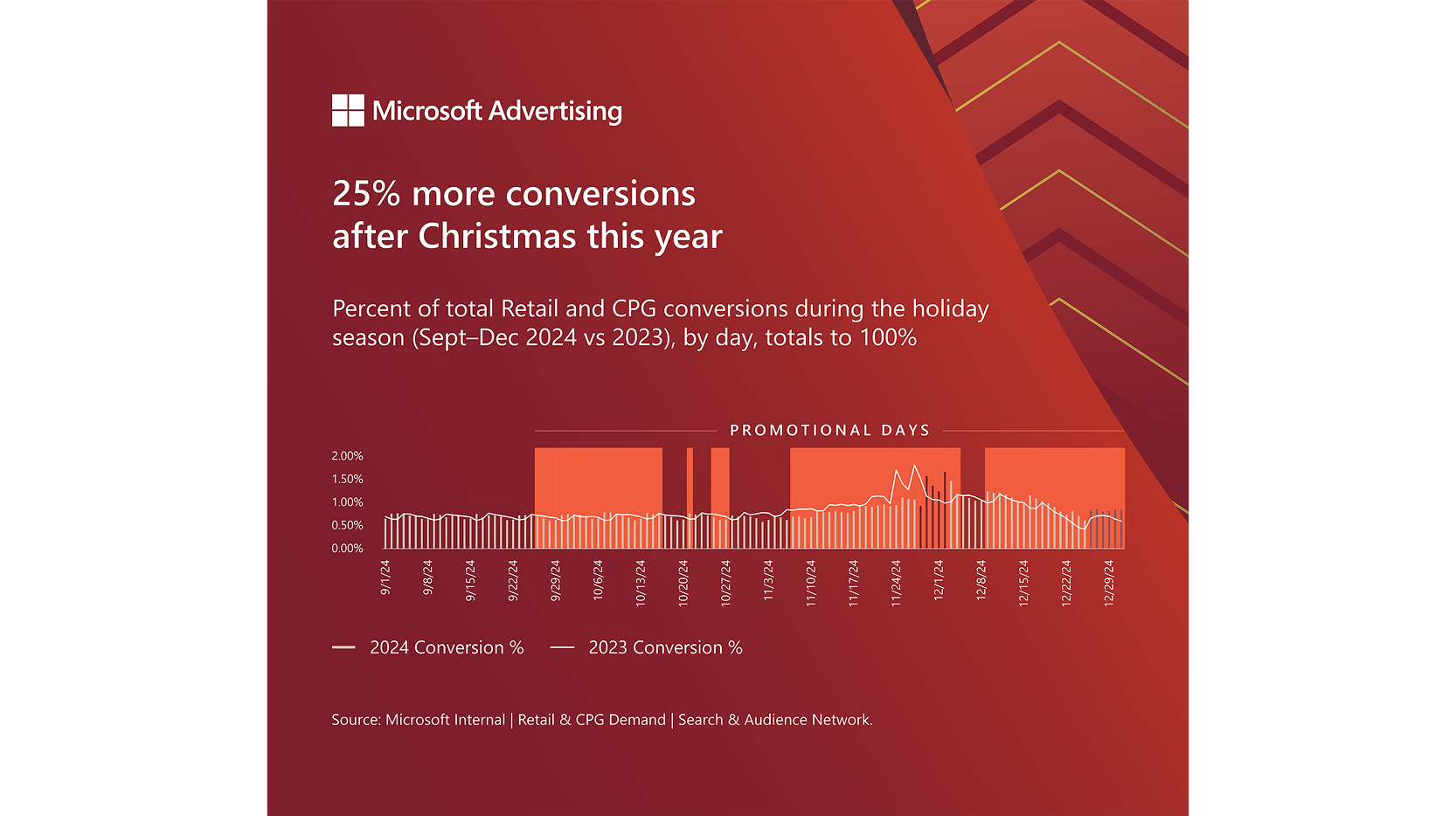
Microsoft Advertising reports a 25% increase in Retail and CPG conversions after Christmas in 2024 compared to 2023.
Other markets noticed similar trends, with countries like Germany and Spain seeing late-season conversions.1 In Australia, consumer purchasing behaviors extended well beyond the traditional peak days, with a 35% increase in conversions and a 15% higher conversion rate sustained into January.3
Winning strategies that delivered results
1. Early product visibility
As customers shift how they shop, investing in early product visibility pays off. In the U.S., the data shows that launching Audience ads ahead of key promotional periods drives site visits and conversions downstream.2
Top advertisers focused their Audience ad investment on dynamic remarketing and feed-based tactics, ramping back up during the peak season. Brands that invested in product category amplification early in the year and holiday season reaped benefits throughout the buying season and into January.2
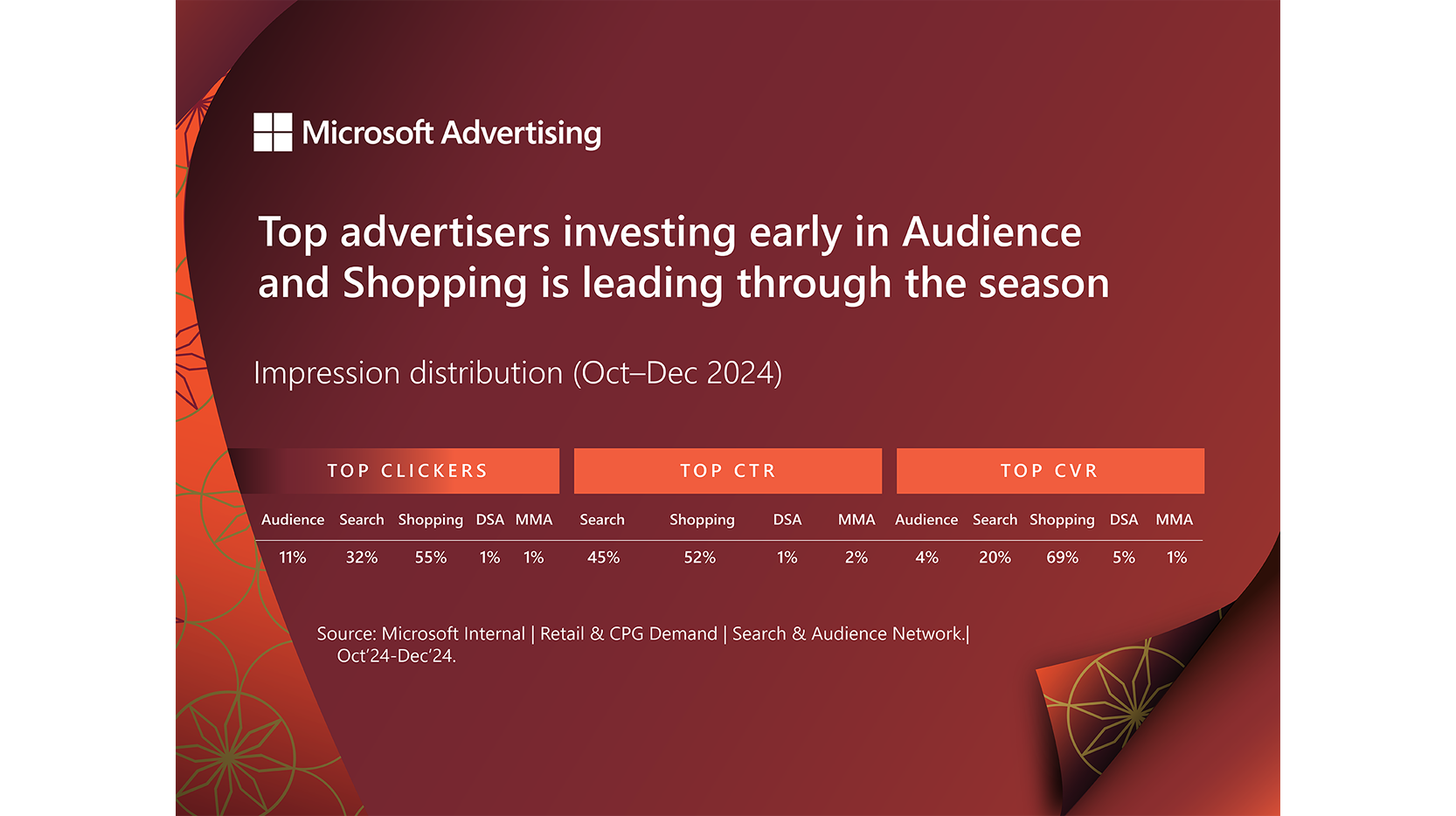
Microsoft Advertising reveals that top advertisers who invested early in Audience campaigns saw strong performance, while Shopping emerged as the leading format for click-through and conversion rates during Q4 2024.
s.Oliver exemplifies this strategy with their "Celebrate Togetherness" campaign, which achieved a 27% conversion rate through impression-based remarketing. By running online video ads from early November to mid-December, they engaged their target audience when purchase intent peaked. The campaign's success highlights how connecting upper-funnel awareness with lower-funnel performance initiatives creates a powerful efficiency ripple effect throughout the customer journey, transforming early visibility into holiday conversions.
2. Multi-format campaigns
Globally, multi-format campaigns help brands stand out. Data from Europe shows that top-performing advertisers stayed ahead of the market by using a multi-format, holistic ad strategy. In regions like Germany and the U.K., these cross-format campaigns drove up to 64% more reach among converters and significantly expanded visibility beyond traditional search-only tactics.1
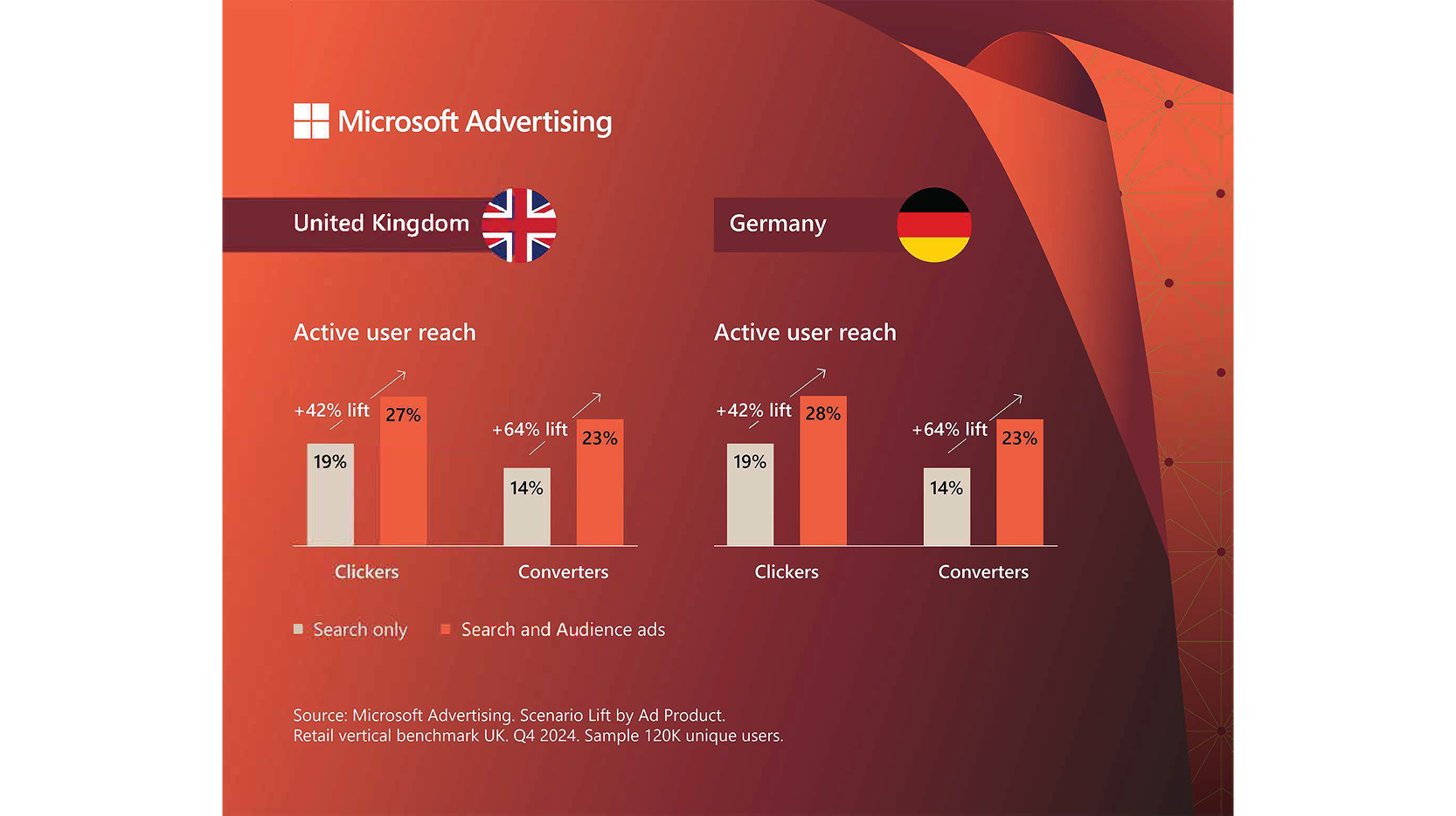
Microsoft Advertising data shows that combining Search and Audience ads significantly boosts active user reach in both the UK and Germany, driving a 42% lift in clickers and a 64% lift in converters compared to Search-only campaigns in Q4 2024.
Look for ways to layer different ad formats, like video, native display, and search ads, to maintain a steady presence from early November through the post-Christmas period.
3. Post-holiday promotions
For advertisers in the U.S., there was a 25% year-over-year increase in conversions during post-Christmas and January promotions, which pointed to revenue and profit opportunities.2 And in countries like France and the Netherlands, conversions were also concentrated earlier in the season compared to prior years.1
Consider developing a campaign plan that extends past the December holidays and runs into the new year. These campaigns can be designed to connect with late-season deal seekers, gift card users, and resolution-driven buyers, keeping opportunities flowing.
4. AI and audience targeting: The dynamic duo of 2024
AI-powered tools are helping advertisers reach new audiences, diversify their formats, and speak more effectively to highly targeted buyers. Part of this was driven by AI solutions like Dynamic Search ads, Performance Max and Ads Studio.
Embracing new tools pays off. For example, Australian advertisers who paired Performance Max alongside search ads saw a 3% lift in conversion rate and an 8% reduction in cost per acquisition.3
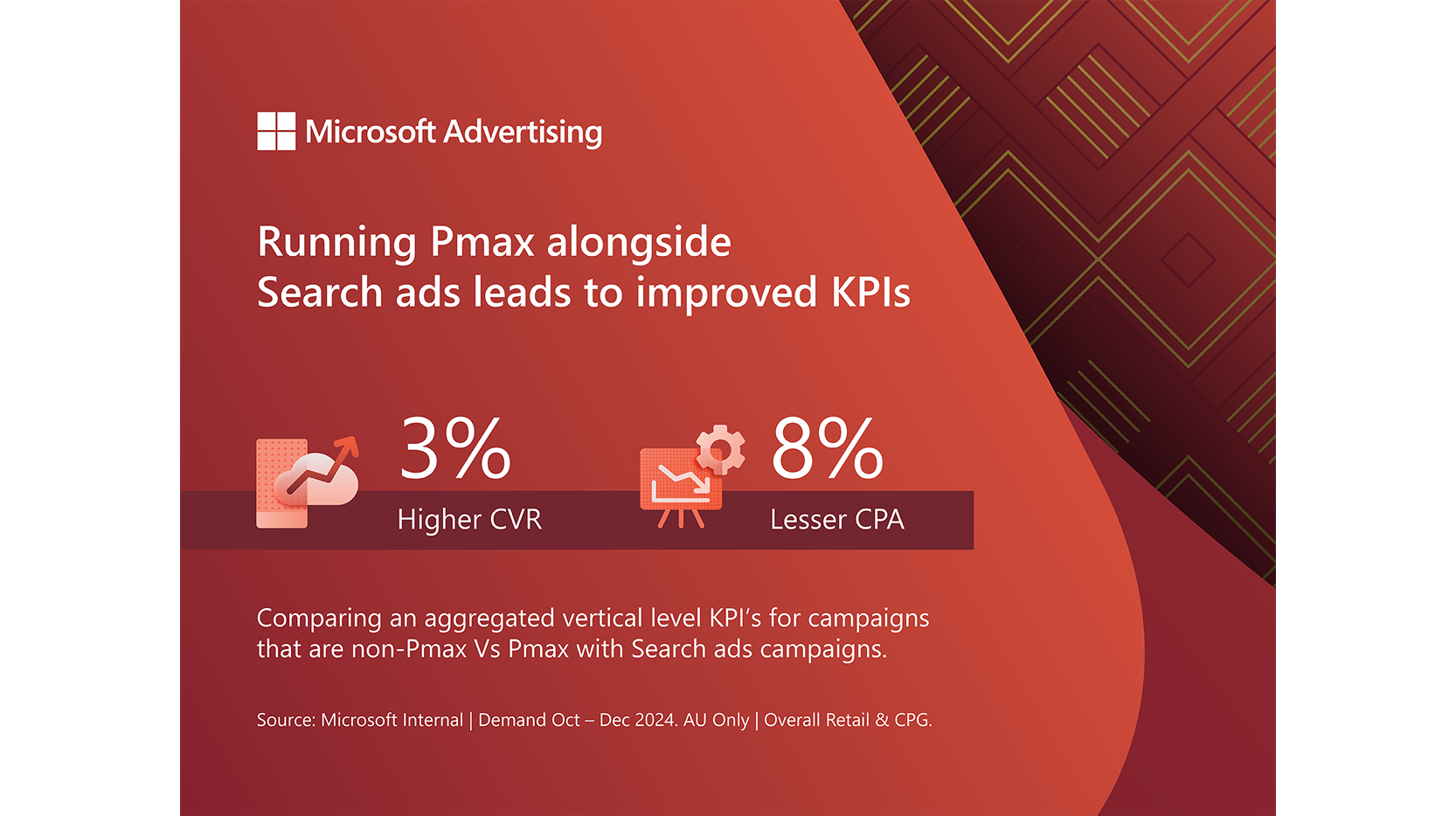
Running Pmax alongside Search ads leads to improved KPIs.
Think of AI and audience targeting as your GPS and co-captain, with one guiding and the other steering campaigns in real time.
Strategic recommendations for 2025
1. Focus on quality of traffic
Reach new audiences—and the right ones—by focusing on quality traffic as part of your broader advertising strategy. Microsoft's ecosystem reaches more than 1 billion permissioned users who spend six to eight hours per day within Microsoft environments (including LinkedIn, Windows, Edge, Bing, and Xbox).
2. Extend campaign duration
Rethink your holiday campaign timing to make the most of engagement and refine that with real-time data. For example, will cost-conscious buyers or those seeking imported gifts start even earlier than usual?
Boosting early category visibility, maintaining consistent investment through the Cyber 5, and maximizing post-holiday opportunities are key to keeping your brand in front of buyers all season long.
3. Try advanced ad formats and targeting
If you’re ready to elevate your advertising, advanced ad formats can help improve performance. Different elements of the Microsoft Advertising toolkit to consider include…
- Performance Max campaigns: For automated optimization across channels.
- Dynamic Search ads: To offer comprehensive coverage.
- Audience ads: For broad reach and engagement.
- Shopping campaigns: To maintain visibility throughout the holiday period.
Your 2025 holiday campaign timeline
Successful brands plan their holiday campaigns months in advance. Use this as the starting point for your planning calendar:
- April/May: Develop holiday awareness strategies with Audience ads. Begin testing AI-powered targeting options and identifying key product categories for early visibility.
- June/July: Plan for lower-funnel support and conversion tactics. Allocate budget across the extended season with greater emphasis on early and post-holiday periods. Start building remarketing audiences.
- August: Test different ad formats and messaging to optimize performance before peak season. Run small-scale experiments with Dynamic Search ads and multi-format campaigns.
- September: Launch early awareness campaigns targeting first-wave holiday shoppers. Implement feed-based tactics and category amplification to build visibility.
- October: Intensify holiday messaging and deploy Performance Max campaigns alongside standard search campaigns. Begin scaling budget for pre-Cyber 5 shoppers.
- November: Deploy full-scale campaigns across all channels and formats. Maintain consistent investment through the Cyber 5 while monitoring real-time performance metrics for optimization.
- December/January: Engage post-holiday shoppers, including those using gift cards or looking for deals. Capitalize on the 25% year-over-year increase in post-Christmas conversions with dedicated January promotions.
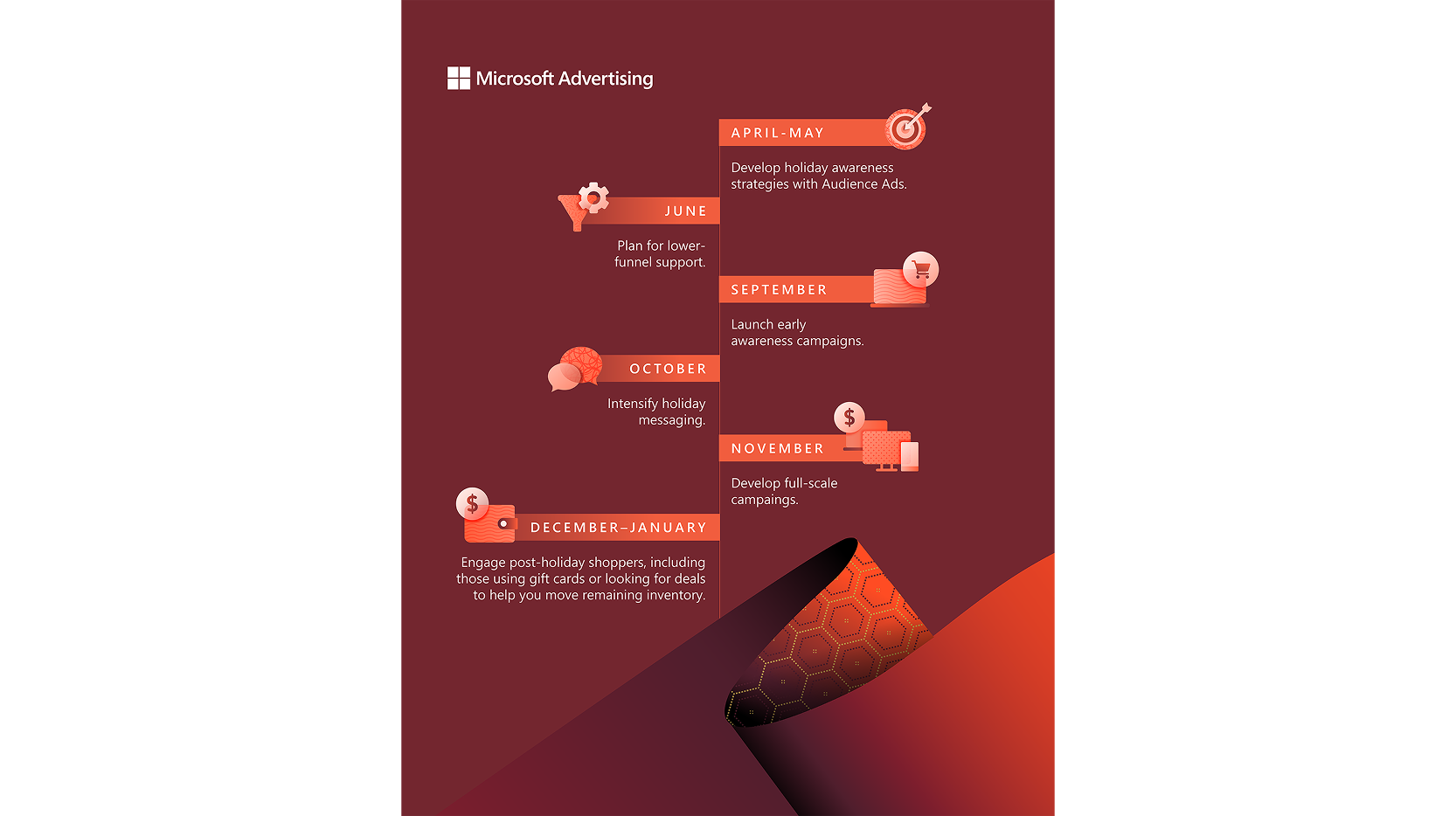
The image is a marketing timeline from Microsoft Advertising, detailing strategies for different months.
Prepare to unwrap growth in 2025
Success always leaves clues, and looking at the most successful advertisers across markets provides a strong blueprint for 2025. Advertisers who embrace AI-driven tools, extend campaign durations, and focus on quality traffic and smart targeting will reach holiday buyers throughout the season.
Let's make 2025 your most successful holiday season yet. Get in touch with Microsoft Advertising and schedule a consultation with our team of experts today to discuss your holiday campaign needs.
[1] Microsoft Internal Data; Period : Sept to Dec 2023 and Sept to Dec 2024 : from -75 days before BF to +15 days after BF each year; Countries : EMEA = UK, DE, FR, NL, ES, IT; (1) Cyber 5 (Thanksgiving->Cyber Monday. (1) x% of the mid-Sep to mid-Dec period
[2] Microsoft Internal | Retail & CPG Demand | Search & Audience Network | Oct’24-Dec’24.
[3] Microsoft Internal | Retail & CPG Demand | Search Network | Oct – Dec 2024. AU Only
Your input makes us better
Take our quick 3-minute survey and help us transform your website experience.


